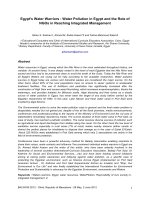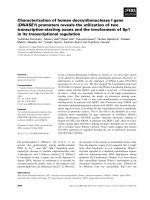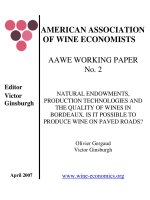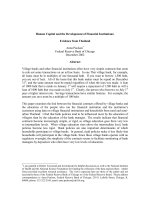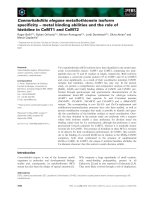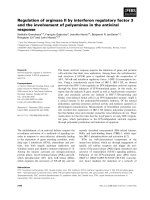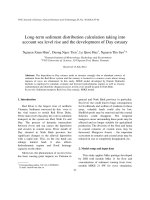FU LEI AND THE DEVELOPMENT OF CULTURE IN MODERN CHINA
Bạn đang xem bản rút gọn của tài liệu. Xem và tải ngay bản đầy đủ của tài liệu tại đây (16.71 MB, 112 trang )
ii
………………………………………………………………………
……………………………………………………… …………
……………………………………
………………
…………………………………………
………………………………………….
……………………
……………………………………………………………
…………………………………………………………...…
……………………………………………
…………………………………..…………
………………………………………………………………………
…………………………………………………………………….…
iii
‟
‟
iv
‟
‟
è
‟
–
–
1
For example: Xu Jianping, Yinghan huyi shijian yu jiqiao (Beijing: Qinghua daxue chubanshe, 2003), p. 7;
Li Ming, Yinghan hudong fanyi jiaocheng (Wuhan: Wuhan daxue chubanshe, 2006), p. 4.
2
For example: Xu Yuanchong, ‘Weishenme chongyi “Yuehan kelisiduofu”?’, Waiguoyu, 4 (1995), pp. 37-40;
Serena Jin, ‘Fuyi “Gao laotou” de yishu’, in Serena Jin, ed. Jiangsheng haodang hua Fu Lei (Beijing:
Dangdai shijie chubanshe, 2006), pp. 209-29; Xu Jun, ‘Zuozhe, yizhe he duzhe de gongming yu
shijieronghe – wenben zaichuangzao de ge’an piping’, Zhongguo fanyi, 23, 3 (2002), pp. 23-7; Wang
Hongtao, ‘Fu Lei yu huomusi mianduimian’, Shanghai fanyi, 4 (2008).
1
‟
„
‟
„
‟
„
„
‟
‟
3
Vera Schwarcz, The Chinese Enlightenment: intellectuals and the legacy of the May Fourth movement of
1919 (Berkeley, LA. and London: University of California Press, 1986), p. 3.
4
Ibid., pp. 2-4.
5
Ibid., pp. 284-6.
2
‟
6
Leo Ou-fan Lee, ‘Incomplete Modernity: Rethinking the May Fourth Intellectual Project’ and Rudolf G.
Wagner, ‘The Canonization of May Fourth’ in Milena Dolezelova-Velingerova and Oldrich Kral, eds., The
Appropriation of Cultural Capital: China’s May Fourth Project (Cambridge, Massachusetts and London,
2001).
7
Geremie R. Barmé, An Artistic Exile: A Life of Feng Zikai (1898-1975) (Berkeley: University of California
Press, 2002).
3
‟
„
‟
„
‟
‟
–
–
„
‟
‟
8
Zhou Yang, cited in Schwarcz, p. 239.
Joseph R. Levenson, Confucian China and its modern fate: the problem of intellectual continuity (London:
Routledge & Kegan Paul, 1958).
9
4
‟
„
„
„
‟
„
‟
‟
‟
„
‟
‟
„
‟–
‟
„
‟
10
Lydia H. Liu, Translingual practice: literature, national culture, and translated modernity--China, 19001937 (Stanford, California: Stanford University Press, 1995).
11
Ibid., p. 82.
12
Ibid., pp. 83-4.
5
‟
‟
‟
–
„
‟
13
Used here as a general term to refer to ‘a system of accepted beliefs which control behavior’
(Cambridge Advanced Learner’s Dictionary, Cambridge: Cambridge University Press, 2003).
6
„
‟
‟
‟
14
D.C. Lau, trans., Mencius, IV. B. 12 (London: Penguin, 2004), p. 90; Gao Zhuancheng, Mengzi tongshuo
(Taiyuan: Shanxi renmin chubanshe, 2004), p. 127.
15
Chen Zishan, ‘Chizi zhixin de zuichu tixian’, Mingbao yuekan, 5 (2008); Xu Jun and Song Xuezhi, eds.,
Zoujin Fu Lei de fanyi shijie (Beijing: Gaodeng jiaoyu chubanshe, 2008), pp. 421-31.
7
‟
–
‟
‟
„
‟
‟
‟
„
‟
‟
„
‟
16
Benjamin I. Schwartz, In search of wealth and power: Yen Fu and the West (Cambridge, Massachusetts:
Belknap Press of Harvard University Press, 1964).
17
Theodore Huters, Bringing the world home: appropriating the West in late Qing and early Republican
China (Honolulu: University of Hawaii Press, 2005), p. 66.
8
–
–
‟
‟
‟
‟
‟
‟
18
Susan Bassnett, ‘The Tranlsation Turn in Cultural Studies’ in Susan Bassnett and André Lefevere,
Constructing Cultures: Essays on Literary Translation (Clevedon: Multilingual Matters, 1998), p. 123.
9
–
–
‟
‟
–
„
‟
19
Romain Rolland, Beethoven the creator: the great creative epochs from the Eroica to the Appassionata,
trans. Ernest Newman (New York: Dover Publications, Inc., 1964).
20
Fu Lei, ‘Beiduofen de zuopin ji qi jingshen’, Fu Lei wenji: wenyijuan (Beijing: Dangdai shijie chubanshe,
2006), p. 605.
21
Ira Bruce Nadel, Biography: fiction, fact and form (London: Macmillan, 1984), p. 8.
10
„
‟
‟
„
‟
‟
22
David Novarr, cited in Nadel, p. 4.
For example: Jin Mei, Fu Lei zhuan (Changsha: Hunan wenyi chubanshe, 1996); Su Liqun, Fu Lei biezhuan
(Beijing: Zuojia chubanshe, 2000).
23
11
‟
‟
‟
–
–
‟
‟
24
Chen Zishan, ‘Chizi zhixin de zuichu tixian’, Mingbao yuekan, 5 (2008).
Examples: Ye Yonglie, Fu Lei huazhuan (Shanghai: Fudan daxue chubanshe, 2005); Ye Yonglie, Fu lei yu
Fu Cong: jiedu “Fu Lei jiashu” (Nanning: Guangxi renmin chubanshe, 2004); Ye Kai, Fu Lei de zuihou 17
nian (Beijing: Zhongguo wenshi chubanshe, 2005); Richard Kraus, Pianos and politics in China: middle class
25
12
‟
‟
‟
‟
‟
‟
‟
ambitions and the struggle over Western music (New York and Oxford: Oxford University Press, 1989); pp.
70-99.
13
‟
14
„
‟
„
‟
„
‟
‟
„
„
‟
‟
‟
–
‟
‟
1
Fu Lei, ‘Letter to Romain Rolland, 3 March 1934’, in Fu Lei wenji: shuxinjuan (Beijing: Dangdai shijie
chubanshe, 2006), pp. 462 – 4.
2
These were Michelangelo and Tolstoy, published in 1935 by the Commercial Press in Shanghai.
Beethoven underwent extensive correction from the version completed in 1932 and was initially adapted
as an abridged commentary (‘Beiduofen pingzhuan’, Guoji yibao 7,1, September 1934). The final version
was published in 1946 as Beiduofen zhuan (Shanghai: Luotuo chubanshe). These biographies made up the
original ‘Lives of Illustrious Men’ series in French.
3
Romain Rolland, ‘Letter from Romain Rolland to the translator: on non-resistance’, 30 June 1934,
reproduced in Mingren zhuan (Nanjing: Yilin chubanshe, 2008), pp. 270 – 1.
15
‟
–
‟
‟
‟
„
‟
4
Fu Lei, ‘Letter to Romain Rolland, 20 August 1934’, trans. Luo Xinzhang, in Fu Lei wenji: shuxinjuan, p.
464.
5
Jin Mei, Fu Lei zhuan (Changsha: Hunan wenyi chubanshe, 1996), p. 158.
6
Megan Conway, ‘Romain Rolland’ in Dictionary of literary biography 332 (Thomson Gale, 2007), p. 46; Su
Liqun, Fu Lei biezhuan (Beijing: Zuojia chubanshe, 2000), p. 102.
7
Rolland was a life-long admirer of Tolstoy and wrote him a series of letters in his youth, to which Tolstoy
replied once. Tolstoy died in 1910 and Rolland wrote the Tolstoy biography a year later.
8
Su Liqun, p. 78; Li Yunlei, Ting Fu Lei jiang yishu (Xi’an: Shaanxi shifan daxue chubanshe, 2008), p. 177.
16
‟
‟
‟
‟
‟
‟
„
‟
‟
‟
‟
9
Chen Sihe, ‘Fu Lei de jingshen yichan’, Wenxue jiaoyu (October 2008), pp. 6-7.
Poshek Fu, Passivity, resistance, and collaboration: intellectual choices in occupied Shanghai, 1937-1945
(Stanford, California: Stanford University Press, 1993), pp. 21-67.
11
Xie Tianzhen and Li Xiaojun, Fu Lei na yuanshi de leihuolinghun (Beijing: Wenjing chubanshe, 2004), pp.
103-4.
10
17
‟
‟
‟
‟
‟
‟
‟
‟
‟
‟
18
„
‟
’
é
‟
„
‟
„
…
‟
‟
‟
–
12
Stefen Zweig, Romain Rolland: the man and his work, trans. Eden and Cedar Paul (London: George Allen
and Unwin, 1921), p. 348.
13
Ibid., pp. 352-3.
14
Romain Rolland, The Forerunners, trans. Eden and Cedar Paul (London: George Allen and Unwin, 1920),
pp. 211-5.
15
‘Jingshen duli xuanyan’, trans. Zhang Songnian, Xin qingnian 7,1 (December 1919), p. 32.
16
Having no access to the original Declaration published in France, New Youth discussed only signatories
chosen from an abridged list of names from the English versions.
19
‟
‟
‟
‟
„
‟
17
‘Benzhi xuanyan’, Xin qingnian 7,1 (December 1919), pp. 1-4.
Vera Schwarcz, The Chinese enlightenment: intellectuals and the legacy of the May Fourth Movement of
1919 (Berkeley and Los Angeles: University of California Press, 1986), p. 119 n. 54.
19
Song Xuezhi, Fanyi wenxue jingdian de yingxiang yu jieshou (Shanghai: Shanghai yiwen chubanshe,
2006), p. 27-8.
20
Leo Ou-fan Lee, The romantic generation of modern Chinese writers (Cambridge, Massachusetts:
Harvard University Press, 1973), p. 35.
18
20
„
‟
‟
„
‟
‟
„
„
„
‟
‟
„
‟
‟
„
„
‟
‟
„
‟
21
Lee, p. 12.
Ibid., p. 32.
23
Ge Baoquan, ‘Tan Fu Lei he Luoman Luolan de tongxin’ in Fuyi zhuanji wuzhong (Beijing: Sanlian shudian,
1983), p. 715.
24
‘Yuehan Kelisiduofu xiang zhongguo de dixiongmen xuanyan’, trans. Jing Yinyu, cited in Ge Baoquan, pp.
715-6.
25
It was observed that it was Rolland’s praise for Ah Q that put the piece ‘on a trajectory of legitimization’
to become a work of ‘world literature’. Ibid., p. 256.
22
21

